Na-Kenyaite as Efficient Basic Blue-41 Dye Removal: Synthesis and Regeneration Studies
Abstract
:1. Introduction
2. Materials and Methods
2.1. Materials
2.2. Preparation of Na-Kenyaite
2.3. Characterization Techniques
2.4. Batch Removal of Basic Blue-41
2.5. Regeneration Tests
2.6. Theoretical Calculation
3. Results and Discussion
3.1. Characterization of Na-Kenyaite Synthesized Materials
3.2. Removal Properties of Basic Blue-41
3.2.1. Effect of Initial Concentrations
3.2.2. Effect of pH
Effect of BB-41 Solution
Influence of Na-Kenyaite Solid pH
3.2.3. Effect of Na-Kenyaite Dosage
3.2.4. Effect of Na-Kenyaite Morphology
3.2.5. Langmuir Adsorption Model
3.2.6. Theoretical Calculation
3.2.7. Regeneration Studies
3.2.8. Design Single-Stage Batch
4. Conclusions
Author Contributions
Funding
Data Availability Statement
Acknowledgments
Conflicts of Interest
References
- Al-Madanat, O.; AlSalka, Y.; Ramadan, W.; Bahnemann, D.W. Tio2 Photocatalysis for the Transformation of Aromatic Water Pollutants into Fuels. Catalysts 2021, 11, 317. [Google Scholar] [CrossRef]
- Ombaka, L.M.; McGettrick, J.D.; Oseghe, E.O.; Al-Madanat, O.; Rieck genannt Best, F.; Msagati, T.A.M.; Davies, M.L.; Bredow, T.; Bahnemann, D.W. Photocatalytic H2 Production and Degradation of Aqueous 2-Chlorophenol over B/N-Graphene-Coated Cu0/Tio2: A Dft, Experimental and Mechanistic Investigation. J. Environ. Manag. 2022, 311, 114822. [Google Scholar] [CrossRef] [PubMed]
- Altarawneh, R.M.; Al-Jaafreh, A.M.; Qaralleh, H.; Al-Qaralleh, O.S. Chemical Profiling of Punica Granatum Peels from Jordan Using Lc–Ms/Ms and Study on Their Biological Activities. Int. J. Food Sci. Tech. 2022, 57, 5256–5267. [Google Scholar] [CrossRef]
- Al-Nasir, F.; Hijazin, T.J.; Al-Alawi, M.M.; Jiries, A.; Al-Madanat, O.Y.; Mayyas, A.; Al-Dalain, S.A.; Al-Dmour, R.; Alahmad, A.; Batarseh, M.I. Accumulation, Source Identification, and Cancer Risk Assessment of Polycyclic Aromatic Hydrocarbons (Pahs) in Different Jordanian Vegetables. Toxics 2022, 10, 643. [Google Scholar] [CrossRef] [PubMed]
- Jiries, A.; Al-Nasir, F.; Hijazin, T.J.; Al-Alawi, M.; El Fels, L.; Mayyas, A.; Al-Dmour, R.; Al-Madanat, O.Y. Polycyclic Aromatic Hydrocarbons in Citrus Fruit Irrigated with Fresh Water under Arid Conditions: Concentrations, Sources, and Risk Assessment. Arab. J. Chem. 2022, 15, 104027. [Google Scholar] [CrossRef]
- Al-Nasir, F.M.; Jiries, A.G.; Al-Rabadi, G.J.; Alu’datt, M.H.; Tranchant, C.C.; Al-Dalain, S.A.; Alrabadi, N.; Madanat, O.Y.; Al-Dmour, R.S. Determination of Pesticide Residues in Selected Citrus Fruits and Vegetables Cultivated in the Jordan Valley. LWT 2020, 123, 109005. [Google Scholar] [CrossRef]
- Lewerenz, L.; Hijazin, T.; Abouzeid, S.; Hänsch, R.; Selmar, D. Pilot Study on the Uptake and Modification of Harmaline in Acceptor Plants: An Innovative Approach to Visualize the Interspecific Transfer of Natural Products. Phytochemistry 2020, 174, 112362. [Google Scholar] [CrossRef] [PubMed]
- Hijazin, T.; Radwan, A.; Lewerenz, L.; Abouzeid, S.; Selmar, D. The Uptake of Alkaloids by Plants from the Soil Is Determined by Rhizosphere Ph. Rhizosphere 2020, 15, 100234. [Google Scholar] [CrossRef]
- Hijazin, T.; Radwan, A.; Abouzeid, S.; Dräger, G.; Selmar, D. Uptake and Modification of Umbelliferone by Various Seedlings. Phytochemistry 2019, 157, 194–199. [Google Scholar] [CrossRef]
- Altarawneh, R.M. Facile Fabrication of New Sensing Platforms Decorated with Quinalizarin and Ptni Alloy Nanoparticles for Highly Sensitive Aluminum Determination. Microchem. J. 2022, 182, 107944. [Google Scholar] [CrossRef]
- Lin, J.; Ye, W.; Xie, M.; Seo, D.H.; Luo, J.; Wan, Y.; Van der Bruggen, B. Environmental Impacts and Remediation of Dye-Containing Wastewater. Nat. Rev. Earth Environ. 2023, 4, 785–803. [Google Scholar] [CrossRef]
- Hung, Y.-T.; Adesanmi, B.; Paul, H.; Huhnke, C. Comparison of Dye Wastewater Treatment Methods: A Review. GSC Adv. Res. Rev. 2022, 10, 126–137. [Google Scholar] [CrossRef]
- Holkar, C.R.; Jadhav, A.J.; Pinjari, D.V.; Mahamuni, N.M.; Pandit, A.B. A Critical Review on Textile Wastewater Treatments: Possible Approaches. J. Environ. Manag. 2016, 182, 351–366. [Google Scholar] [CrossRef]
- Alanazi, A.M.; Al Dmour, H.; Popoola, S.A.; Oudghiri Hassani, H.; Rakass, S.; Al-Faze, R.; Kooli, F. Parameters Synthesis of Na-Magadiite Materials for Water Treatment and Removal of Basic Blue-41: Properties and Single-Batch Design Adsorber. Inorganics 2023, 11, 423. [Google Scholar] [CrossRef]
- Benvenuti, J.; Fisch, A.; dos Santos, J.H.Z.; Gutterres, M. Silica-Based Adsorbent Material with Grape Bagasse Encapsulated by the Sol-Gel Method for the Adsorption of Basic Blue 41 Dye. Environ. Chem. Eng. 2019, 7, 103342. [Google Scholar] [CrossRef]
- Kooli, F.; Liu, Y.; Al-Faze, R.; Al Suhaimi, A. Effect of Acid Activation of Saudi Local Clay Mineral on Removal Properties of Basic Blue 41 from an Aqueous Solution. Appl. Clay Sci. 2015, 116–117, 23–30. [Google Scholar] [CrossRef]
- Afshin, S.; Rashtbari, Y.; Vosoughi Niri, M.; Rehman, R.; Ramavandi, B.; Behzad, A.; Mitu, L. Removal of Basic Blue-41 Dye from Water by Stabilized Magnetic Iron Nanoparticles on Clinoptilolite Zeolite. Rev. Chim. 2020, 71, 218–229. [Google Scholar] [CrossRef]
- Kooli, F.; Yan, L.; Al-Faze, R.; Al-Sehimi, A. Removal Enhancement of Basic Blue 41 by Brick Waste from an Aqueous Solution. Arab. J. Chem. 2015, 8, 333–342. [Google Scholar] [CrossRef]
- Zarezadeh-Mehrizi, M.; Badiei, A. Highly Efficient Removal of Basic Blue 41 with Nanoporous Silica. Water Resour. Ind. 2014, 5, 49–57. [Google Scholar] [CrossRef]
- Kul, A.R.; Aldemir, A.; Koyuncu, H. An Investigation of Natural and Modified Diatomite Performance for Adsorption of Basic Blue 41: Isotherm, Kinetic, and Thermodynamic Studies. Desalin. Water Treat. 2021, 229, 384–394. [Google Scholar] [CrossRef]
- Humelnicu, I.; Băiceanu, A.; Ignat, M.-E.; Dulman, V. The Removal of Basic Blue 41 Textile Dye from Aqueous Solution by Adsorption onto Natural Zeolitic Tuff: Kinetics and Thermodynamics. Process Saf. Environ. Prot. 2017, 105, 274–287. [Google Scholar] [CrossRef]
- Mersin, G.; Açıkel, Ü.; Levent, M. Efficient Adsorption of Basic Blue 41 from Textile Wastewaters by Natural and Magnetically Modified Manisa-Gördes Clinoptilolite. Chem. Eng. Process. 2021, 169, 108632. [Google Scholar] [CrossRef]
- Kosuge, K.; Yamazaki, A.; Tsunashima, A.; Otsuka, R. Hydrothermal Synthesis of Magadiite and Kenyaite. J. Ceram. Soc. Jpn. 1992, 100, 326–331. [Google Scholar] [CrossRef]
- Kooli, F.; Mianhui, L.I.; Plevert, J. Comparative Studies on the Synthesis of Na-Magadiite, Na-Kenyaite and Rub-18 Phases. Clay Sci. 2006, 12, 25–30. [Google Scholar] [CrossRef]
- Beneke, K.; Lagaly, G. Kenyaite; Synthesis and Properties. Am. Mineral. 1983, 68, 818–826. [Google Scholar]
- Wang, Z.; Pinnavaia, T.J. Intercalation of Poly(Propyleneoxide) Amines (Jeffamines) in Synthetic Layered Silicas Derived from Ilerite, Magadiite, and Kenyaite. J. Mater. Chem. 2003, 13, 2127–2131. [Google Scholar] [CrossRef]
- Marler, B.; Grosskreuz, I.; Gies, H. The Crystal Structure of Synthetic Kenyaite, Na2Si20O40(OH)2·8H2O. J. Solid State Chem. 2021, 300, 122215. [Google Scholar] [CrossRef]
- Scott, M.; Auerbach, K.A.C.; Prabir, K.D. Chapter 11: Alkali Silicates and Crystalline Silicic Acids, 1st ed.; CRC Press: Boca Raton, FL, USA, 2004. [Google Scholar]
- Fatima, H.; Seo, J.-D.; Kim, J.; Park, M. Adsorption Behavior of Kenyaite for Cu2+ and Pb2+. J. Porous Mater. 2022, 29, 111–117. [Google Scholar] [CrossRef]
- Ariyapala, K.D.S.D.; Withanage, W.I.U.; Takimoto, K.; Kumada, N.; Takei, T.; Saito, N.; Horikoshi, H. Ion-Exchange and Antibacterial Properties of Layered Silicate, Na-Kenyaite, Prepared Using Amorphous Silicon Dioxide (a-SiO2) Blocks. J. Ceram. Soc. Jpn. 2024, 132, 39–44. [Google Scholar] [CrossRef]
- Feng, F.; Balkus, K.J. Synthesis of Kenyaite, Magadiite and Octosilicate Using Poly(Ethylene Glycol) as a Template. J. Porous Mater. 2003, 10, 5–15. [Google Scholar] [CrossRef]
- Fletcher, R.A.; Bibby, D.M. Synthesis of Kenyaite and Magadiite in the Presence of Various Anions. Clays Clay Miner. 1987, 35, 318–320. [Google Scholar] [CrossRef]
- Kalvachev, Y.; Kostov-Kytin, V.; Todorova, S.; Tenchev, K.; Kadinov, G. Synthetic Kenyaite as Catalyst Support for Hydrocarbon Combustion. Appl. Catal. B Environ. 2006, 66, 192–197. [Google Scholar] [CrossRef]
- Guerra, D.L.; Airoldi, C.; Viana, R.R. Adsorption of Arsenic(V) into Modified Lamellar Kenyaite. J. Hazard. Mater. 2009, 163, 1391–1396. [Google Scholar] [CrossRef] [PubMed]
- Kooli, F.; Liu, Y.; Hbaieb, K.; Ching, O.Y.; Al-Faze, R. Characterization of Organo-Kenyaites: Thermal Stability and Their Effects on Eosin Removal Characteristics. Clay Miner. 2018, 53, 91–104. [Google Scholar] [CrossRef]
- Kwon, O.Y.; Park, K.W. The Preparation of Flaky Layered Carbon by Using Layered Silicate Template. Bull. Korean Chem. Soc. 2003, 24, 1561–1562. [Google Scholar]
- Oliveira, M.E.R.; da Silva Filho, E.C.; Filho, J.M.; Ferreira, S.S.; Oliveira, A.C.; Campos, A.F. Catalytic Performance of Kenyaite and Magadiite Lamellar Silicates for the Production of A,Β-Unsaturated Esters. Chem. Eng. J. 2015, 263, 257–267. [Google Scholar] [CrossRef]
- Royer, B.; Cardoso, N.F.; Lima, E.C.; Ruiz, V.S.O.; Macedo, T.R.; Airoldi, C. Organofunctionalized Kenyaite for Dye Removal from Aqueous Solution. J. Colloid Interface Sci. 2009, 336, 398–405. [Google Scholar] [CrossRef] [PubMed]
- Sassi, M.; Miehé-Brendlé, J.; Patarin, J.; Bengueddach, A. Na-Magadiite Prepared in a Water/Alcohol Medium: Synthesis, Characterization and Use as a Host Material to Prepare Alkyltrimethylammonium- and Si-Pillared Derivates. Clay Miner. 2005, 40, 369–378. [Google Scholar] [CrossRef]
- Kwon, O.Y.; Park, K.W.; Paek, U.H. Direct Synthesis of Na·Kenyaite from Amorphous Silica. J. Korean Assoc. Cryst. Growth 1999, 9, 70–73. [Google Scholar]
- Sirinakorn, T.; Imwiset, K.; Bureekaew, S.; Ogawa, M. Inorganic Modification of Layered Silicates toward Functional Inorganic-Inorganic Hybrids. Appl. Clay Sci. 2018, 153, 187–197. [Google Scholar] [CrossRef]
- Kooli, F.; Liu, Y.; Abboudi, M.; Oudghiri Hassani, H.; Rakass, S.; Ibrahim, S.M.; Al Wadaani, F. Waste Bricks Applied as Removal Agent of Basic Blue 41 from Aqueous Solutions: Base Treatment and Their Regeneration Efficiency. Appl. Sci. 2019, 9, 1237. [Google Scholar] [CrossRef]
- Kebir, Z.A.M.; Adel, M.; Adjdir, M.; Bengueddach, A.; Sassi, M. Preparation and Antibacterial Activity of Silver Nanoparticles Intercalated Kenyaite Materials. Mater. Res. Express 2018, 5, 085021. [Google Scholar] [CrossRef]
- Aicha, B.; Mohamed, S.; Jocelyne, M.-B.; Benedicte, L.; Jean-Luc, B.; Abdelkader, B. Preparation of New Microporous Titanium Pillared Kenyaite Materials Active for the Photodegradation of Methyl Orange. J. Porous Mater. 2018, 25, 801–812. [Google Scholar] [CrossRef]
- Mochizuki, D.; Kuroda, K. Design of Silicate Nanostructures by Interlayer Alkoxysilylation of Layered Silicates (Magadiite and Kenyaite) and Subsequent Hydrolysis of Alkoxy Groups. New J. Chem. 2006, 30, 277–284. [Google Scholar] [CrossRef]
- Huang, Y.; Jiang, Z.; Schwieger, W. Vibrational Spectroscopic Studies of Layered Silicates. Chem. Mater. 1999, 11, 1210–1217. [Google Scholar] [CrossRef]
- Shtenberg, M.V.; Popov, V.A.; Lebedeva, S.M.; Zainullina, R.T.; Rassomakhin, M.A. Vibrational Spectroscopy of Kenyaite and Magadiite in the Southern Urals. In Proceedings of the Minerals: Structure, Properties, Methods of Investigation, Ekaterinburg, Russia, 5–8 February 2020; pp. 237–243. [Google Scholar]
- Yang, J.; Zhu, J.; Zhang, S.; Lv, T.; Feng, Z.; Wang, Y.; Meng, C. Osda-Free Hydrothermal Conversion of Kenyaite into Zeolite Beta in the Presence of Seed Crystals. Solid State Sci. 2020, 107, 106370. [Google Scholar] [CrossRef]
- Eypert-Blaison, C.; Humbert, B.; Michot, L.J.; Pelletier, M.; Sauzéat, E.; Villiéras, F. Structural Role of Hydration Water in Na- and H-Magadiite: A Spectroscopic Study. Chem. Mater. 2001, 13, 4439–4446. [Google Scholar] [CrossRef]
- Jeong, S.-Y.; Suh, J.-K.; Jin, H.; Lee, J.-M.; Kwon, O.-Y. Preparation of Molecular Sieve from Pillaring of Kenyaite: Effects of Catalysts on Gellation of Intercalated Teos. J. Colloid Interface Sci. 1996, 180, 269–275. [Google Scholar] [CrossRef]
- Borade, R.B.; Clearfield, A. Hydrothermal Synthesis of an Iron Silicate with Layered Structure. Chem. Commun. 1997, 3, 277–278. [Google Scholar] [CrossRef]
- Crone, I.A.; Franklin, K.R.; Graham, P. A New Route for the Preparation of Hydrated Alkali-Metal Silicates. J. Mater. Chem. 1995, 5, 2007–2011. [Google Scholar] [CrossRef]
- Bi, Y.; Lambert, J.-F.; Millot, Y.; Casale, S.; Blanchard, J.; Zeng, S.; Nie, H.; Li, D. Relevant Parameters for Obtaining High-Surface Area Materials by Delamination of Magadiite, a Layered Sodium Silicate. J. Mater. Chem. 2011, 21, 18403–18411. [Google Scholar] [CrossRef]
- Koike, M.; Grosskreuz, I.; Asakura, Y.; Miyawaki, R.; Gies, H.; Wada, H.; Shimojima, A.; Marler, B.; Kuroda, K. Bridging the Gap between Zeolites and Dense Silica Polymorphs: Formation of All-Silica Zeolite with High Framework Density from Natural Layered Silicate Magadiite. Chemistry 2023, 29, e202301942. [Google Scholar] [CrossRef]
- Abbas, M.; Harrache, Z.; Trari, M. Mass-Transfer Processes in the Adsorption of Crystal Violet by Activated Carbon Derived from Pomegranate Peels: Kinetics and Thermodynamic Studies. J. Eng. Fibers Fabr. 2020, 15, 1558925020919847. [Google Scholar] [CrossRef]
- Abbas, M.; Trari, M. Mass Transfer Process in the Removal of Congo Red (Cr) onto Natural Clay (Nc): Kinetic, Isotherm Modeling, and Thermodynamic Study. J. Water Clim. Change 2023, 14, 2755–2772. [Google Scholar] [CrossRef]
- Al Dmour, H.; Kooli, F.; Mohmoud, A.; Liu, Y.; Popoola, S.A. Al and Zr Porous Clay Heterostructures as Removal Agents of Basic Blue-41 Dye from an Artificially Polluted Solution: Regeneration Properties and Batch Design. Materials 2021, 14, 2528. [Google Scholar] [CrossRef] [PubMed]
- Aziz, E.; Boutouil, A.; el Himri, M.; Rachid, L.; El Haddad, M. Selective and Competitive Removal of Three Basic Dyes from Single, Binary and Ternary Systems in Aqueous Solutions: A Combined Experimental and Theoretical Study. J. Saudi Chem. Soc. 2020, 24, 527–544. [Google Scholar] [CrossRef]
- Mokhtar, M. Application of Synthetic Layered Sodium Silicate Magadiite Nanosheets for Environmental Remediation of Methylene Blue Dye in Water. Materials 2017, 10, 760. [Google Scholar] [CrossRef]
- Swenson, H.; Stadie, N.P. Langmuir’s Theory of Adsorption: A Centennial Review. Langmuir 2019, 35, 5409–5426. [Google Scholar] [CrossRef]
- Roulia, M.; Vassiliadis, A.A. Interactions between C.I. Basic Blue 41 and Aluminosilicate Sorbents. J. Colloid Interface Sci. 2005, 291, 37–44. [Google Scholar] [CrossRef]
- Baskar, A.V.; Bolan, N.; Hoang, S.A.; Sooriyakumar, P.; Kumar, M.; Singh, L.; Jasemizad, T.; Padhye, L.P.; Singh, G.; Vinu, A.; et al. Recovery, Regeneration and Sustainable Management of Spent Adsorbents from Wastewater Treatment Streams: A Review. Sci. Total Environ. 2022, 822, 153555. [Google Scholar] [CrossRef]
- Şentürk, İ.; Alzein, M. Adsorptive Removal of Basic Blue 41 Using Pistachio Shell Adsorbent–Performance in Batch and Column System. Sustain. Chem. Pharm. 2020, 16, 100254. [Google Scholar] [CrossRef]
- Alanazi, A.M.; Jefri, O.A.; Alam, M.G.; Al-Faze, R.; Kooli, F. Organo Acid-Activated Clays for Water Treatment as Removal Agent of Eosin-Y: Properties, Regeneration, and Single Batch Design Absorber. Heliyon 2024, 10, e30530. [Google Scholar] [CrossRef] [PubMed]
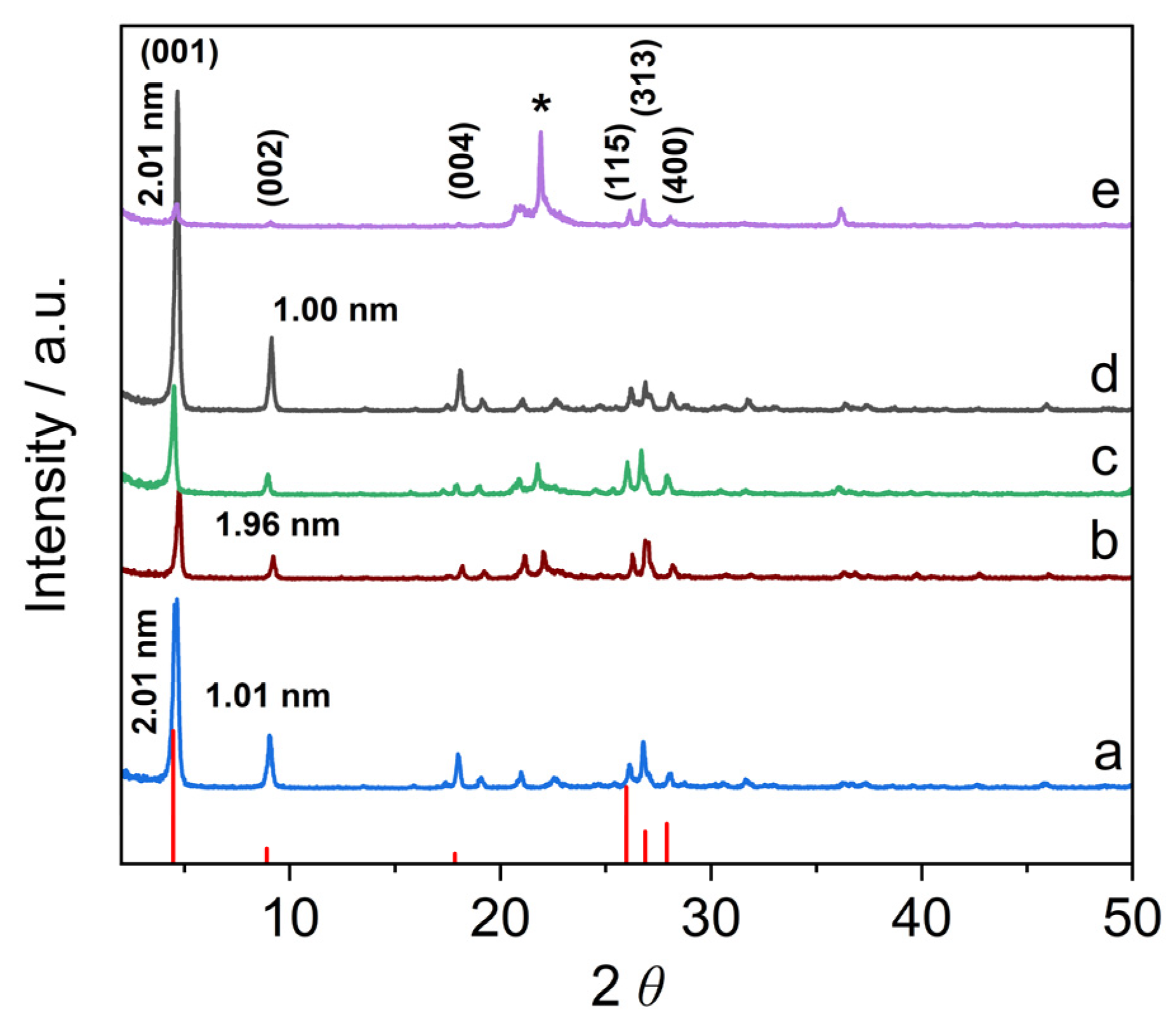
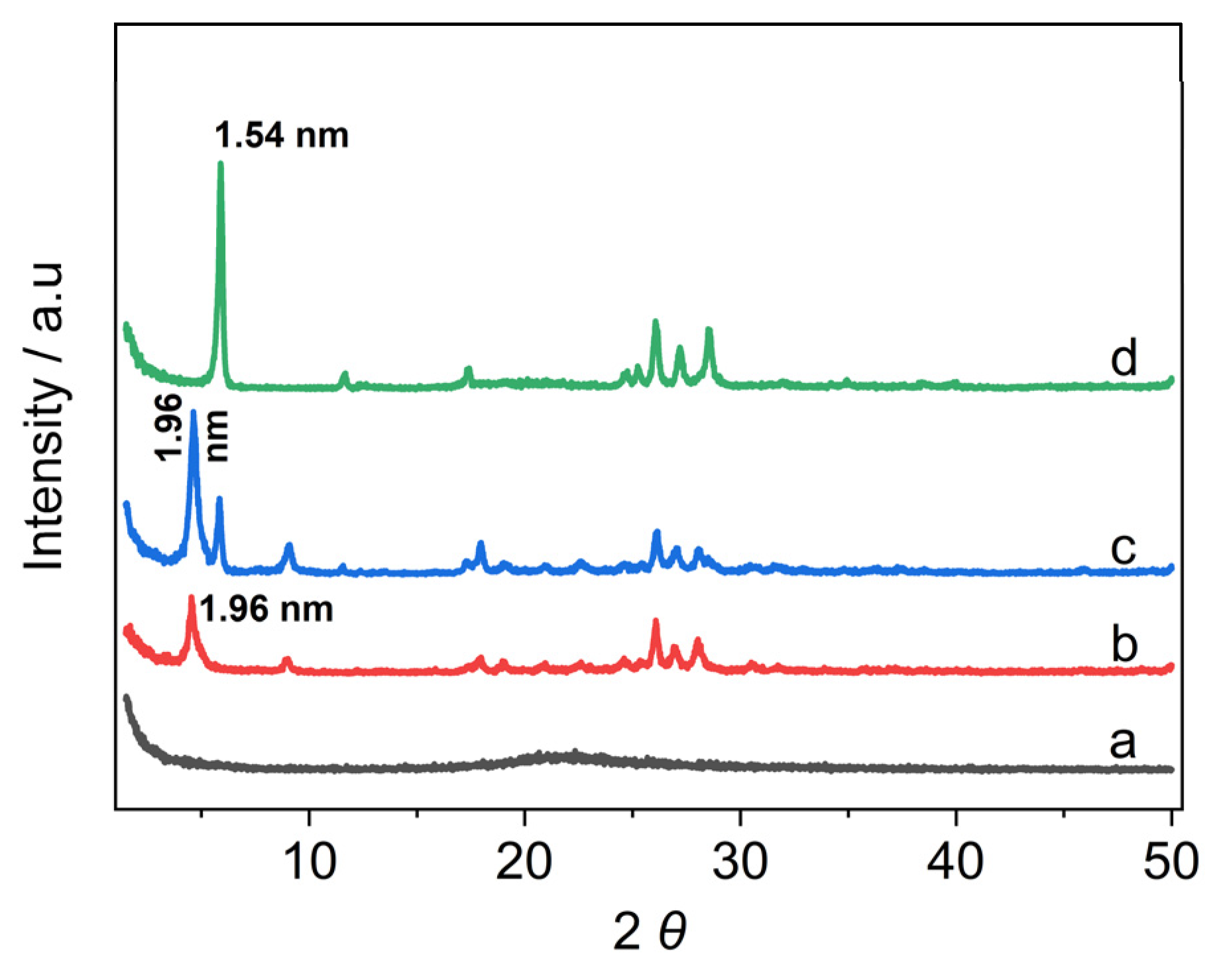
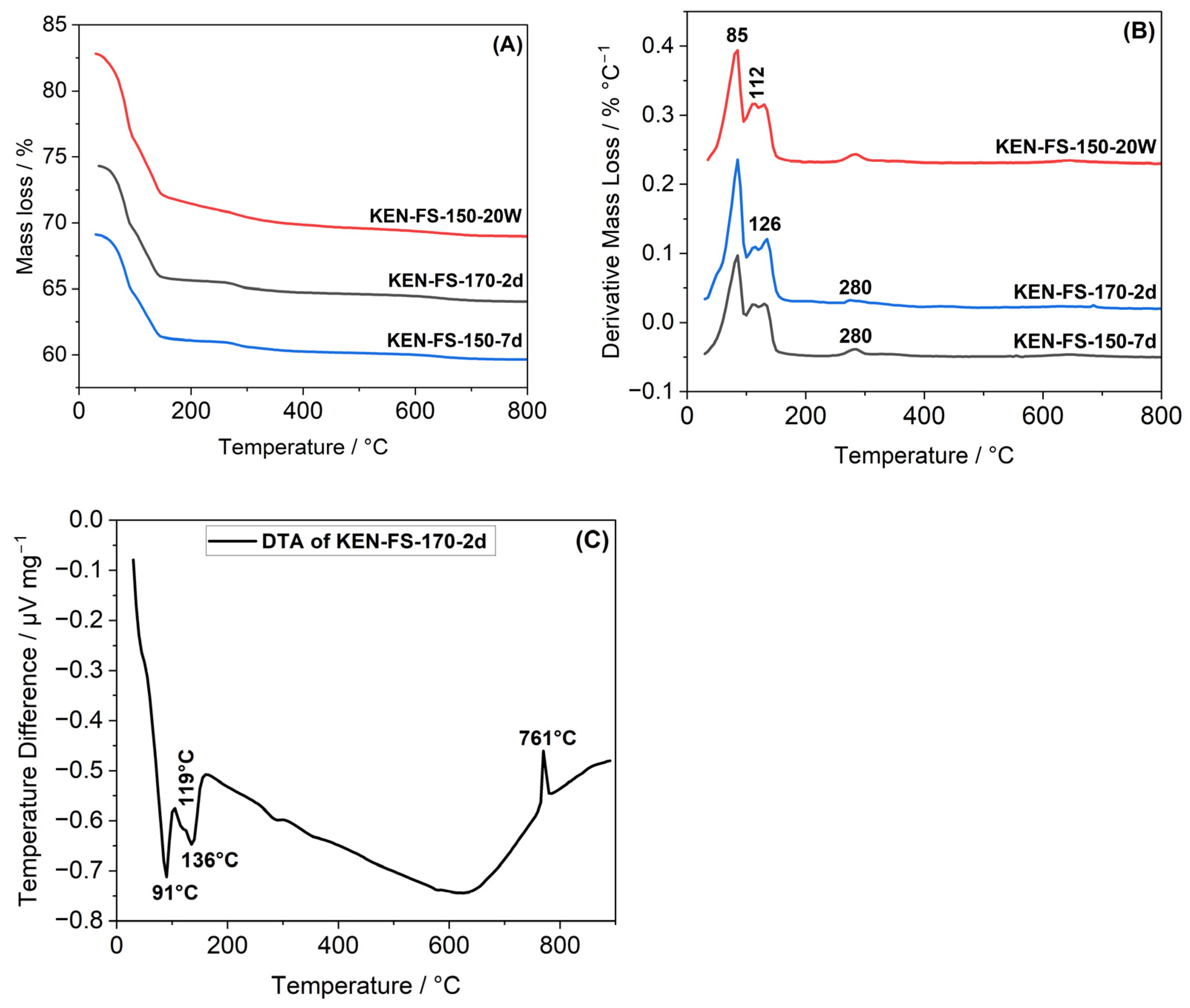

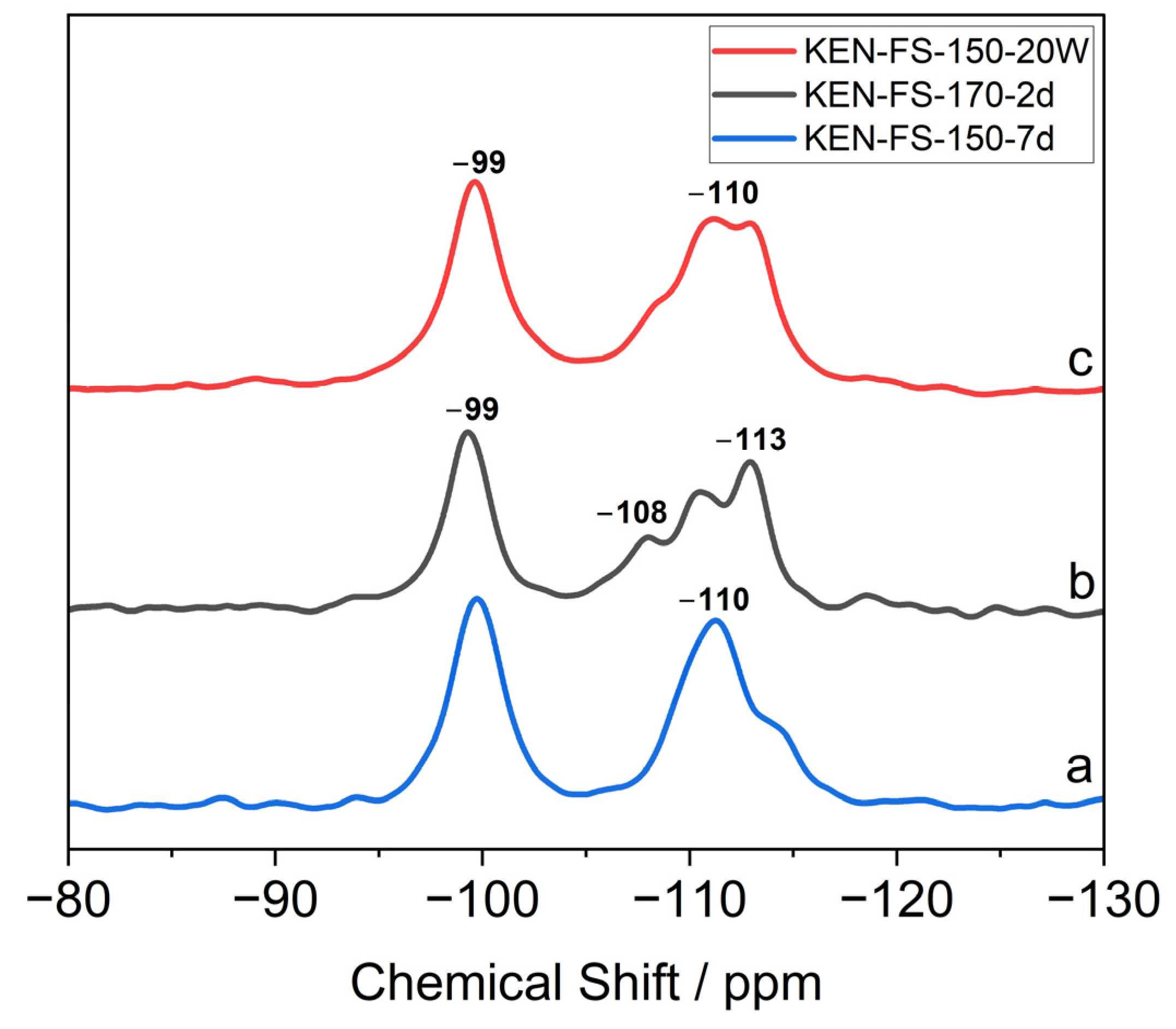
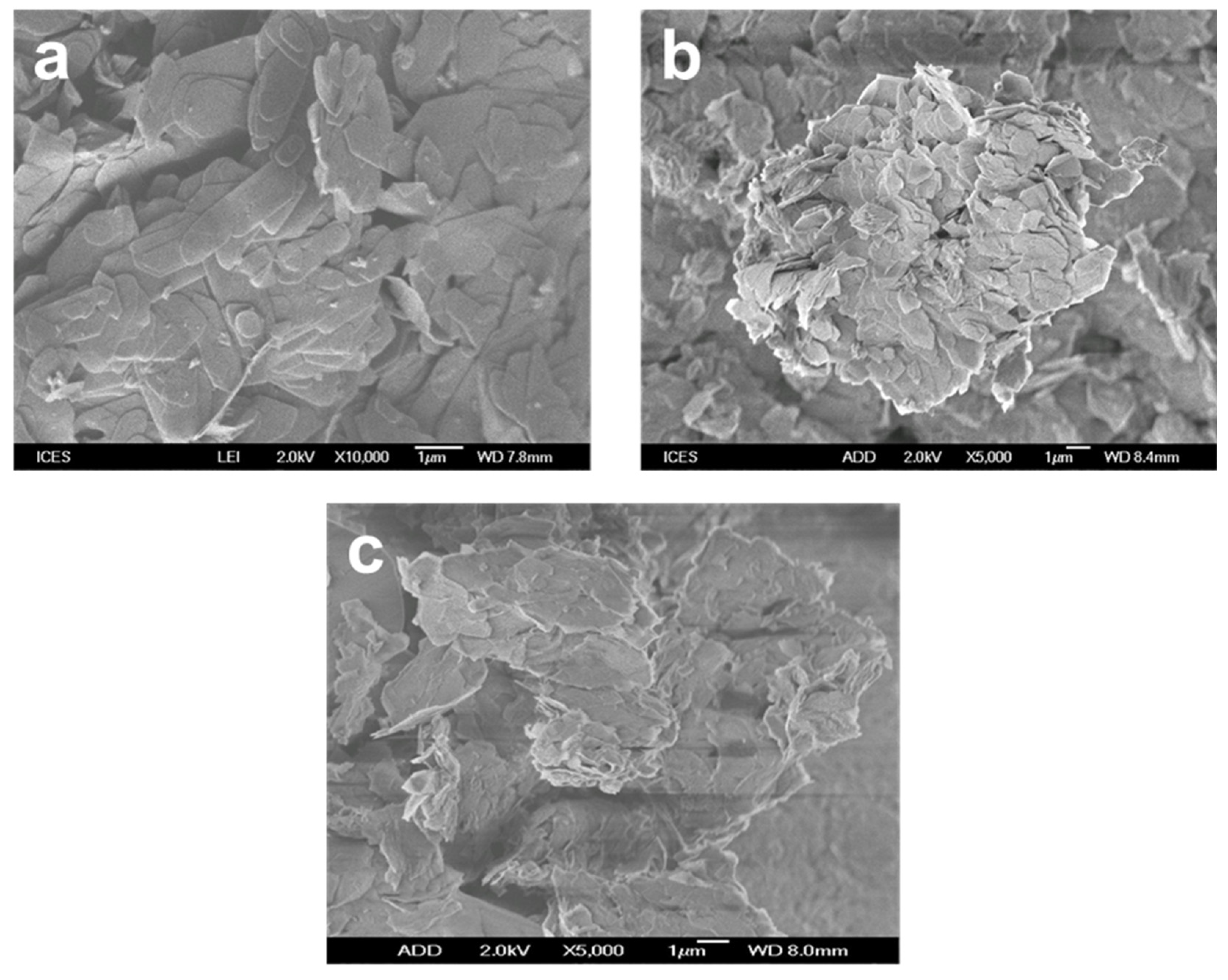

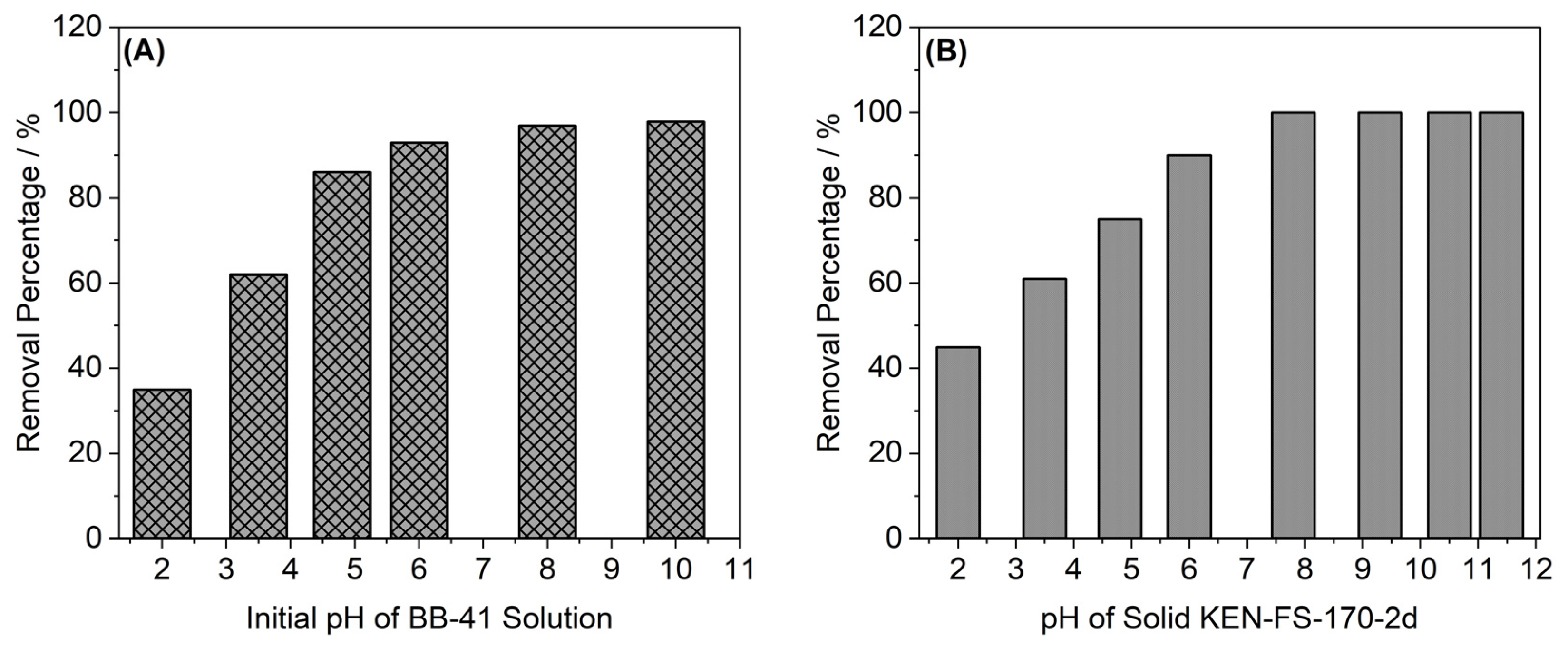
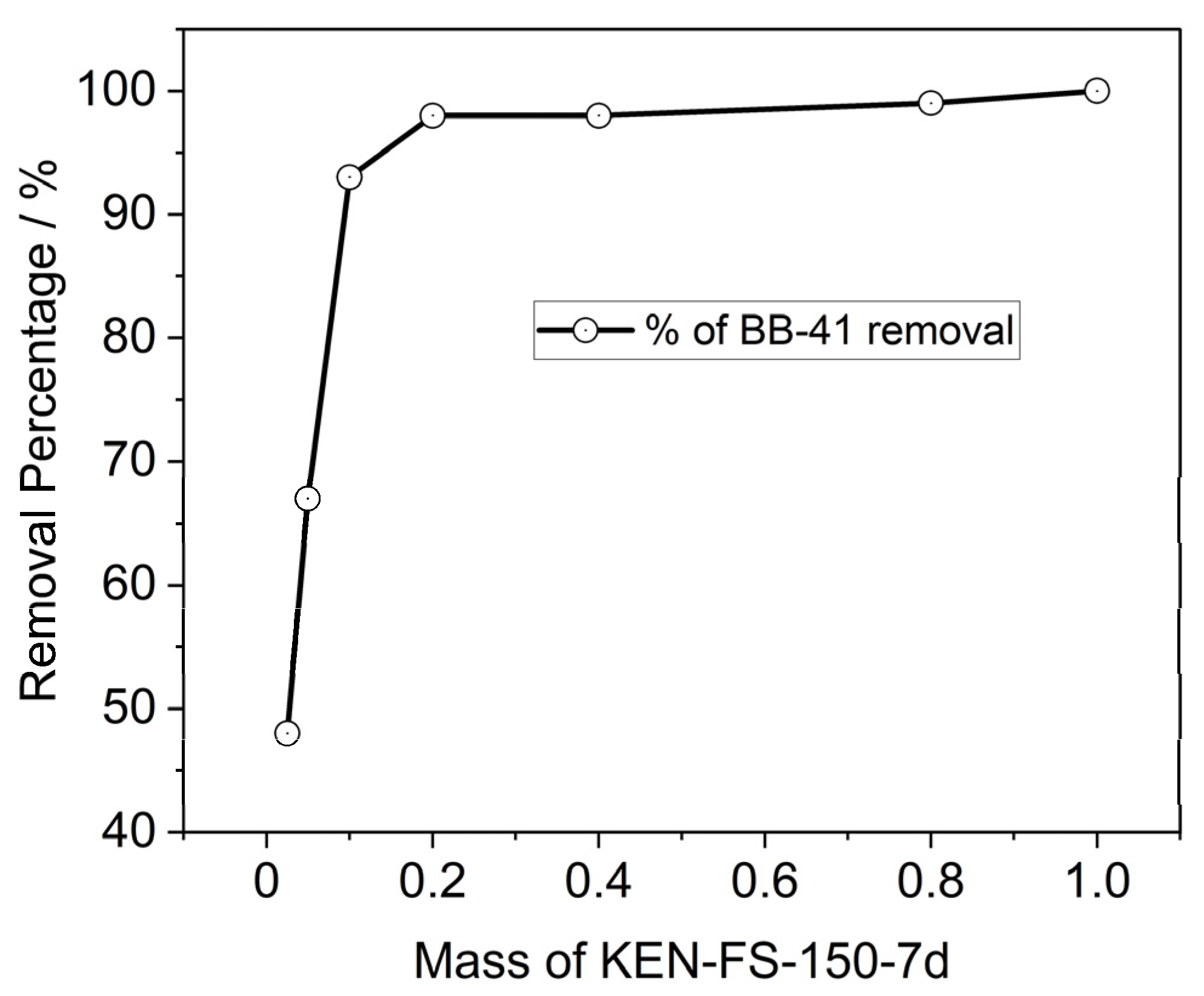
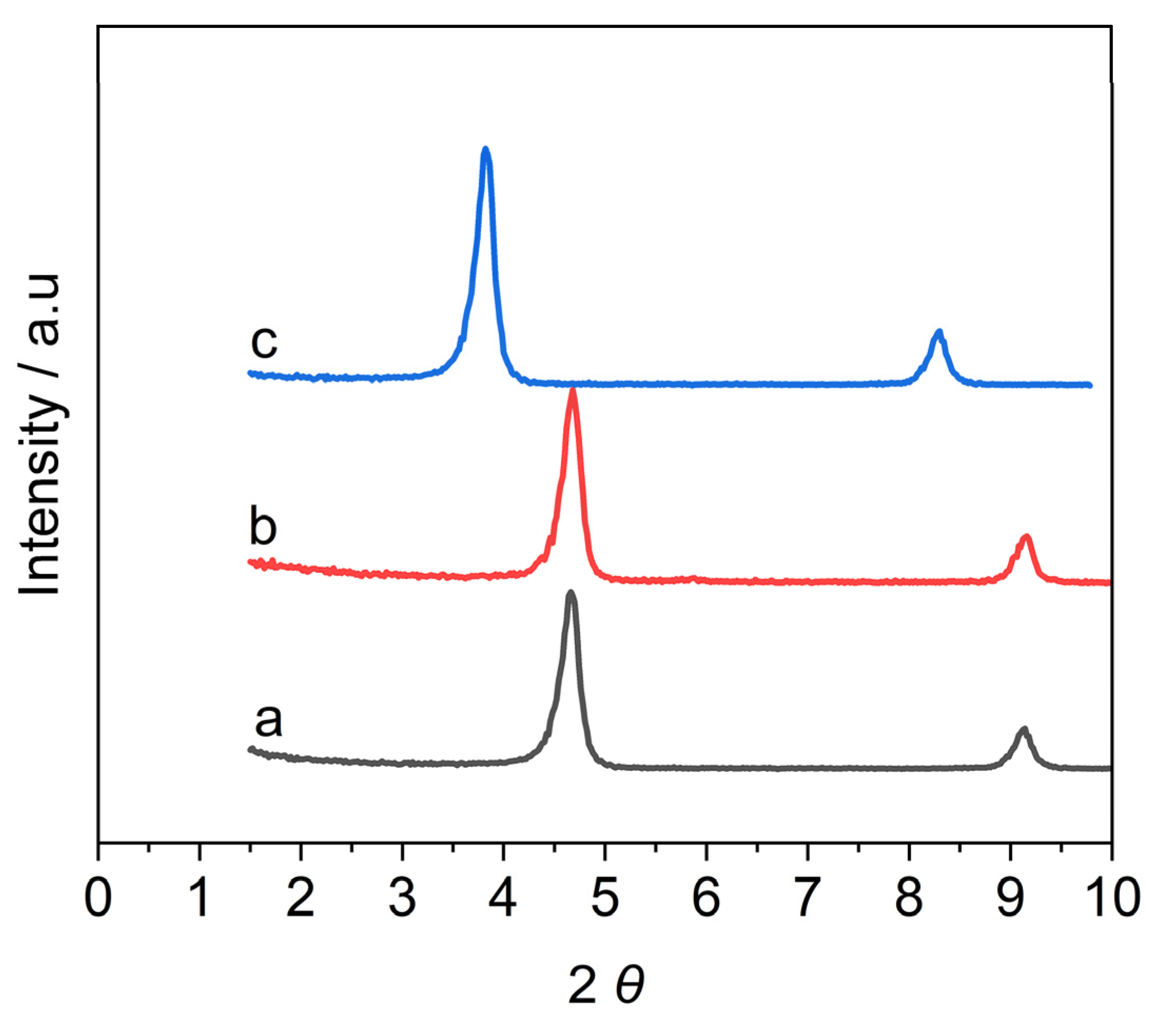
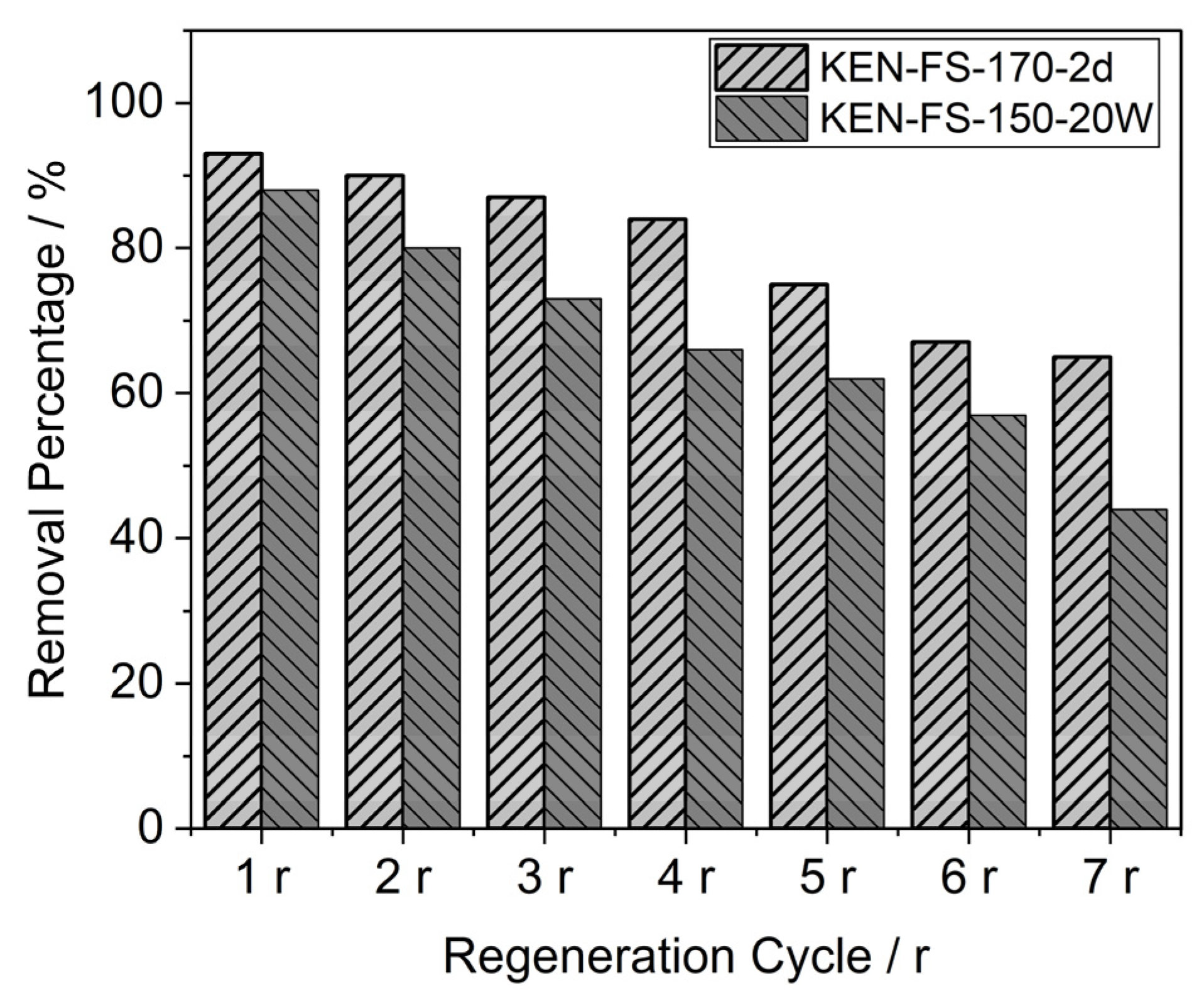
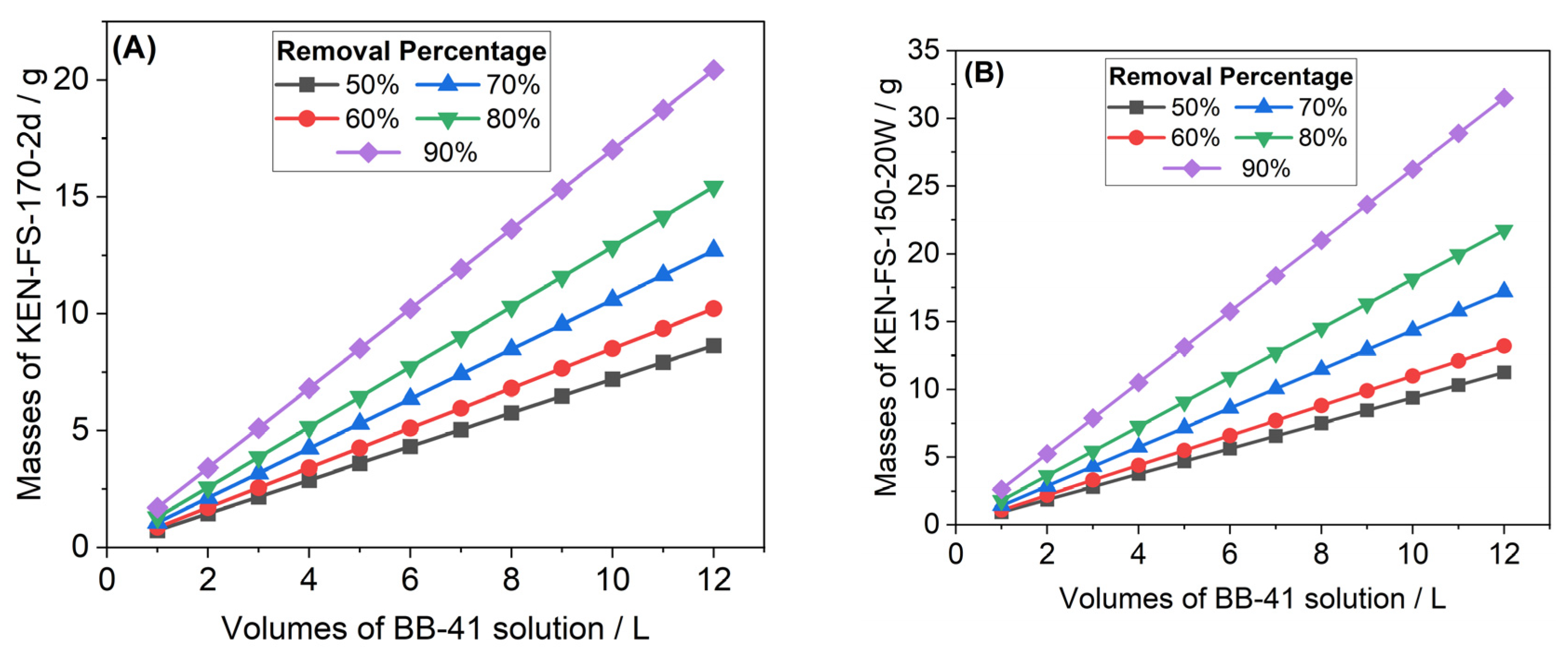
| Used Material | Removal Efficiency (mg/g) | Ref. |
|---|---|---|
| Na-magadiites | 150–220 | [14] |
| Sol-gel silica synthesized from grape bagasse | 268 | [15] |
| Saudi Arabia-local clay mineral | 74 | [16] |
| Clinoptilolite/Fe3O4 nanoparticles | 192 | [17] |
| Brick waste materials | 60–70 | [18] |
| Silica nanoporous particles | 345 | [19] |
| Mn-modified diatomite | 62 | [20] |
| Zeolite tuff | 93 | [21] |
| Natural Gordes zeolite | 149 | [22] |
| Run | Silica Source | NaOH (g) | SiO2 (g) | H2O (g) | Temp (°C) | Time (h) | Phase | Assignment |
|---|---|---|---|---|---|---|---|---|
| 1 | Fumed Silica | 4.80 | 45.00 | 105.00 | 150 | 7 | 1 Ken | KEN-FS-150-7d |
| 2 | 4.80 | 45.00 | 105.00 | 150 | 10 | Ken + silica | KEN-FS-150-10d | |
| 3 | 4.80 | 45.00 | 105.00 | 170 | 2 | Ken | KEN-FS-170-2d | |
| 4 | 4.80 | 45.00 | 20.00 | 150 | 2 | Ken | KEN-FS-150-20W | |
| 5 | 4.80 | 45.00 | 10.00 | 150 | 2 | 2 Amp silica | KEN-FS-150-10W | |
| 6 | 4.80 | 45.00 | 40.00 | 150 | 2 | Ken + mag | KEN-FS-150-40W | |
| 7 | Colloidal | 4.80 | 45.00 | 105.00 | 170 | 2 | Ken | KEN-CS-170-2d |
| 8 | Silica | 4.80 | 45.00 | 105.00 | 150 | 7 | Ken + silica | KEN-CS-150-7d |
| 9 | Ludox-HS 40% | 4.80 | 45.00 | 105.00 | 150 | 7 | Traces Ken + silica | KEN-HS-150-7d |
| 10 | Ludox-AS 40% | 4.80 | 45.00 | 105.00 | 150 | 10 | 3 Mag + Ken + silica | KEN-AS-150-7d |
| Samples | qmax (mg/g) | KL (L/g) | R2 |
|---|---|---|---|
| KEN-FS-150-7d | 147.20 (151.10) | 0.2433 (0.1166) | 0.9997 |
| KEN-FS-170-2d | 136.60 (138.60) | 0.1137 (0.0955) | 0.9997 |
| KEN-FS-150-20W | 118.70 (123.70) | 0.1046 (0.0621) | 0.9993 |
| KEN-CS-150-7d | 124.20 (128.20) | 0.1095 (0.1023) | 0.9995 |
| KEN-CS-170-2d | 165.30 (171.30) | 0.2764 (0.1542) | 0.9997 |
Disclaimer/Publisher’s Note: The statements, opinions and data contained in all publications are solely those of the individual author(s) and contributor(s) and not of MDPI and/or the editor(s). MDPI and/or the editor(s) disclaim responsibility for any injury to people or property resulting from any ideas, methods, instructions or products referred to in the content. |
© 2024 by the authors. Licensee MDPI, Basel, Switzerland. This article is an open access article distributed under the terms and conditions of the Creative Commons Attribution (CC BY) license (https://creativecommons.org/licenses/by/4.0/).
Share and Cite
Al-Madanat, O.Y.; Popoola, S.A.; Al Dmour, H.; Al-Faze, R.; Kooli, F. Na-Kenyaite as Efficient Basic Blue-41 Dye Removal: Synthesis and Regeneration Studies. Water 2024, 16, 2056. https://doi.org/10.3390/w16142056
Al-Madanat OY, Popoola SA, Al Dmour H, Al-Faze R, Kooli F. Na-Kenyaite as Efficient Basic Blue-41 Dye Removal: Synthesis and Regeneration Studies. Water. 2024; 16(14):2056. https://doi.org/10.3390/w16142056
Chicago/Turabian StyleAl-Madanat, Osama Y., Saheed A. Popoola, Hmoud Al Dmour, Rawan Al-Faze, and Fethi Kooli. 2024. "Na-Kenyaite as Efficient Basic Blue-41 Dye Removal: Synthesis and Regeneration Studies" Water 16, no. 14: 2056. https://doi.org/10.3390/w16142056





